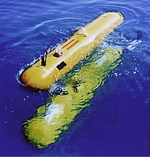Tools and Instruments

Large-scale sea floor imaging tools.
Image and animation coming soon from Earthguide.
Animated diagram
Why use sound instead of light to create images? You can't see to the bottom of the ocean by shining a light from a ship. Light doesn't get very far through the water column. Sound does. In fact, waves similar to sound are able to go through solid rock -- these are earthquake waves.
What is it about light that allows us to see? When we see things, we are actually seeing the light that bounces off objects. When there is no source of light, it's dark because there are no light waves bouncing around for our eyes to detect.
Sound waves can be used in a similar way to "see" things. After turning on a sound source, we can look at the pattern of reflected sound waves that bounce back to us. Our own ears and brain don't process sound into mental pictures. However, there is a way to do this using mathemetical methods, an understanding of physics, instrumentation, and computing tools. This is the basic scheme of all sonar-based imaging techniques.
Large-scale imaging techniques using sound (or other mechanical waves) include:
- Sonar - oldest and least expensive method to measure bathymetry
- Multibeam - more expensive way to get better coverage in measuring bathymetry
- Side-scan sonar - way to produce images of specific objects or ground textures on the seafloor
- Sub-bottom profiling - ways to see underground layering and other structures
Coming soon.
Where to find more information:
Sound-based (acoustic) imaging techniques
Mapping Techniques: Acoustics
Summary of major techniques, including sonar, multibeam, side-scan sonar, and sub-bottom profiling.
NOAA Coastal Services Center
Side-Scan Sonar Images
fromVoyage to Puna Ridge
Side-Scan and Multibeam Sonar
Office of Coast Survey, NOAA
Mapping
Ocean Explorer: Technology, NOAA
Sonar (Echo-sounding)
Sonar
Ocean Explorer: Technology, NOAA
Sounding Out the Ocean's Secrets
About the historical development of sonar-based techniques in studying the ocean.
National Academy of Sciences
Image examples

Wrecks of the schooners Frank A. Palmer and Louise B. Crary.
Photo courtesy NOAA.
Perspective image of U.S.G.S. map data.
Visible Earth, NASA
Multibeam Mapping of the Los Angeles, California Margin
Images that show the shape of the seafloor offshore Los Angeles and Orange Counties, California.
U.S. Geological Survey
Pacific Sea-Floor Mapping Images
Images of the seafloor from many locations on the Pacific Coast including Lake Tahoe and Crater Lake.
Western Regional Coastal & Marine GeologyU.S. Geological Survey
First Image of Historic Shipwrecks Released on 100th Anniversary of Palmer-Crary Loss, December 16, 2002
Side-scan sonar images of the wreck.
Stellwagen Bank National Marine Sanctuary, NOAA
Stellwagen Bank Sanctuary Releases New Shipwreck Images on 104th Anniversary of Portland Loss, November 26, 2002
Side-scan sonar images of the wreck.
Stellwagen Bank National Marine Sanctuary, NOAA
Whales and Walrus: Tillers of the Seafloor
Side-scan images reveal feeding pits scoured by gray whales and walruses.
Hans Nelson, Marine and Coastal Geology Program, U.S. Geological Survey
Produced in collaboration with Scripps Institution of Oceanography.
Website by Earthguide.
© 2003-2004 by the Ocean Institute
and the Regents of the University of California.
All rights reserved.
Last modifed Monday, December 10, 2004

